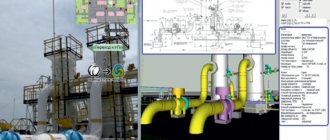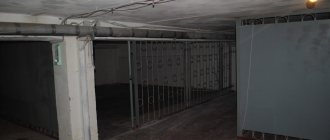Requirements for installing elevators in low-rise residential buildings
We are all accustomed to the fact that in houses with less than 8–9 floors, as a rule, there is no elevator. This often creates inconvenience for residents, especially disabled people, other citizens with limited mobility and mothers with strollers and bicycles.
In this regard, changes were made to the Town Planning Code of the Russian Federation and Building Codes and Rules concerning the design of residential buildings up to 12–14 m in height.
The current SNiP 54.13330.2011 (clause 4.8) defines the following requirements for the arrangement of elevators:
- the minimum level of the floor of the upper floor above the floor of the lower floor is 12 m;
- the required number of elevators depending on the number of floors (Appendix D to the SNiP data provides standards for the number of elevators. Thus, in buildings up to 9 floors, 1 mechanism is sufficient);
- certain width and depth of the cabin and its doors;
- mandatory installation of an elevator in houses where disabled and elderly people live.
In accordance with Resolution of the Cabinet of Ministers of the Russian Federation 1521 of December 26, 2014, clauses on the minimum building height and living conditions for groups with limited mobility are mandatory.
In other words, elevators must be provided in houses whose size is larger than this (above 12 m to the floor of the last floor). If there is a note in the design documentation of the building about the status of future residents as a “low-mobility group” and about their planned placement in apartments above the first floor, the requirements become even more stringent. In such cases, builders must be guided by the following rule: in residential buildings where the second or subsequent floors will be inhabited, including by disabled people or families with a disabled person, passenger elevators or lifting platforms must be installed. This also applies to specialized buildings built for elderly people and families with disabilities.
A similar point is contained in SNiP 59.13330.2012 (clause 5.2.17). It states that in order to ensure unhindered access for wheelchair users to floors of a building located above or below the main level, it is necessary to equip it with lifting platforms or passenger elevators. The technical specifications for the projects prescribe a specific method of lifting disabled people, the possibility of using various options and duplicating them.
Thus, the current legislation provides for the presence of elevators even in 2-story buildings if people from the MBG live in them. For other buildings, height restrictions apply.
You can get professional advice on the need to install an elevator in a building of a certain type, number of floors and height at LLC “GK RusStroyEkspertiza”.
Lift replacement time
Advice from lawyers:
1. The elevator is not turned on after replacement; all deadlines have passed. Where to contact?
1.1. Good afternoon With a claim to your Criminal Code.
Did the answer help you?YesNo
Consultation on your issue
8
Calls from landlines and mobiles are free throughout Russia
2. Deadline for replacing an elevator in a 9-story building in Moscow.
2.1. It depends on how old your elevator is from the moment it was installed. And in the elevator itself there must be a sign with its service life. If not, then contact the management company or homeowners association to clarify this information. Sincerely.
Did the answer help you?YesNo
3. How long does it take to replace an elevator in a 9-story building?
3.1. Hello Olga! According to clause 5 of Art. 4 of the Technical Regulations of the Customs Union “Safety of Elevators” TR. TS 011/2011, approved by decision of the Customs Union Commission dated October 18, 2011 N 824, if the passport of an elevator put into operation before the entry into force of this technical regulation does not contain information about the assigned service life, the assigned service life of the elevator is set equal to 25 years from the date putting it into operation. By virtue of clause 3.4 of Art. 4 of this regulation, after the expiration of the designated service life, it is not allowed to use the elevator for its intended purpose without conducting a conformity assessment in order to determine the possibility and conditions for extending the life of the elevator for its intended purpose, performing modernization or replacement, taking into account the conformity assessment.
Did the answer help you?YesNo
4. What is the best way to file claims and a lawsuit against the Federal Financial Institution and the management organization “Zhilishchnik” - major repairs of elevators are not being carried out, the OSS regarding the postponement of the replacement of the elevator has been ignored (for a year now). An examination of the elevators was carried out and paid from the HOA account. Should the plaintiff be an individual, for example, the Chairman of the HOA or a LEGAL ENTITY of the HOA? Please justify your opinion and the cost of filing a claim on this topic.
4.1. If the chairman writes a lawsuit on his own behalf, then he can then speak in defense of his interests. The plaintiff must be a partnership (but represented by the chairman).
Did the answer help you?YesNo
4.2. If TSN has an agreement with Zhilischny, then of course the plaintiff is a legal entity Zhilischnik.
Did the answer help you?YesNo
4.3. Svetlana, the claim can be filed on behalf of TSN. It can be signed by the director, that is, the chairman of the partnership. Please check the cost of filing a claim by contacting one or another of the lawyers who responded to you, by phone or in personal messages.
Did the answer help you?YesNo
5. According to the announcement, the elevator in our building will be turned off for 60 days for replacement. The contractor explains that the deadlines were set by the regional operator. What to do in this case.
5.1. What is a regional operator? Whoever pays for the services agrees on the terms.
Did the answer help you?YesNo
6. An individual entrepreneur made repairs in an apartment building. Namely, replacing old elevator equipment with new ones, the question is how long is the warranty period established by law for the work performed.
6.1. Good evening. According to the supply agreement, a warranty period is established for the product (set by the manufacturer) - According to the passport for elevator equipment, the manufacturer has established a warranty period. I hope I helped you.
Did the answer help you?YesNo
7. The elevators in the building are being replaced. The elevator in the first entrance was turned off on September 5. The work has now been completed, but the elevator has not been put into operation. Recently the elevators in other entrances were turned off. Deadlines are written for the entire house until December 16th. Is it possible to demand that the elevator be put into operation now, given that no work is being carried out in the first entrance.
7.1. It's impossible to say for sure. It all depends on the terms of the concluded contract under which the repairs are carried out. If its terms allow such a shutdown before a certain date, it will not be possible to force it to be turned on.
Did the answer help you?YesNo
8. The elevators have reached the end of their service life (the house is 30 years old), so they replaced them. The question is - from what means? From the budget or from the capital repair fund?
8.1. Good afternoon The elevators are being replaced using funds from the Capital Repair Fund! You must have a passport of the object posted on your house indicating the customer!
Did the answer help you?YesNo
9. Are the deadlines for dismantling and installing elevator equipment in an apartment building prescribed by law? I am interested in the period for which they have the right to turn off the elevator in connection with the replacement.
9.1. The downtime of one elevator during its replacement depends on the number of floors of an apartment building: up to 9 floors - 30 days; 10 - 12 floors - 35 days; 14 floors - 40 days; 16 - 17 floors - 45 days; 22 - 26 floors - 60 days. Overhaul department.
Did the answer help you?YesNo
10. On June 5, 2020, the elevator was turned off to replace it with a new one in a 9-story building. According to the plan, the elevator will be connected on August 14, 2020. Is there a set time frame for dismantling and installing a new elevator?
10.1. Good afternoon Elevators will be stopped only after all equipment necessary for installation has been delivered to the residential building. The downtime of one elevator during its replacement depends on the number of floors of an apartment building: - up to 9 floors - 30 days; — 10 — 12 floors — 35 days; — 14 floors — 40 days; – 16 – 17 floors – 45 days; — 22 — 26 floors — 60 days. When replacing an elevator in a frame-attached shaft, the downtime of the elevator is 80 days. All new elevators will have a service life of 25 years from the date of their commissioning. At the end of this period, routine safety diagnostics of the main components and assemblies of the lift are usually carried out. Please note: according to the standards, until the elevator is officially put into operation, its use for transporting people or goods, not related to its installation, adjustment and testing, is not permitted. Sincerely.
Did the answer help you?YesNo
11. The elevator has been replaced for three months now. How long does it take to replace an elevator? Which law should I rely on?
11.1. Draft Federal Law N 360017-7 introduces fines of up to 350,000 rubles to management companies for poor maintenance of elevators, print the draft and go to the management show them, maybe they don’t know, if you ignore the application to the prosecutor’s office.
Did the answer help you?YesNo
12. Time frame for setting up elevator equipment after replacing the elevator.
12.1. Good afternoon The period must be reasonable. By law, no more than 7 working days. Sincerely.
Did the answer help you?YesNo
13. What document regulates the timing of replacement of elevator equipment? We have a 9-story house. The replacement period was set at 3.5 months?!
13.1. Depends on the warranty period established by the manufacturer.
Did the answer help you?YesNo
Consultation on your issue
8
Calls from landlines and mobiles are free throughout Russia
14. What deadlines must housing companies adhere to for replacing elevators?
14.1. Good afternoon Maybe. I’ll answer a little off topic, but still. Of course, the service life of elevators is officially established; there are some regulations, I don’t remember them exactly (about 20 years somewhere). But here’s what I wanted to focus on - if my memory serves me right, then work on replacing elevator equipment is included in the work on major repairs of common property in apartment buildings, for which regional operators are currently responsible, and the work is carried out according to the corresponding regional program (if people collect money on the account of such a regional operator), developed and approved in each subject of the Russian Federation. It’s just that at present, housing companies can move away from this and blame everything on this regional operator, since in the case of the formation of a capital repair fund on the account of a regional operator, they are not responsible for carrying out major repairs (replacing an elevator), maintaining it in normal technical condition and current renovation - yes, but not major.
Did the answer help you?YesNo
15. What is the scheduled time frame for replacing an elevator in a 9-story building?
15.1. According to current regulations, the service life of a passenger elevator located in an apartment building should not exceed 25 years. Once the specified period comes to an end, further operation of the facility is prohibited. The management company or homeowners association must organize a check of the operability of the elevator units.
Did the answer help you?YesNo
16. In our 9-storey building, the elevator was replaced from July 4, 2018 to October 5, 2018. Is this period for replacing the elevator legal or should I go somewhere else with a complaint?
16.1. The deadlines for completing the work are specified in the contract. You need to read the contract agreement. If the repair organization was hired by the management company, they are obliged to familiarize you with the contract. The deadlines may be postponed, but you have the right to go to court and recover moral damages. You have the right to recover damages from the date the elevator is put into operation under the terms of the contract. You must attach to the statement of claim a copy of the documents that prove your violated right; the court must provide the originals of these documents for review, or attach to the claim a Petition to request these documents from the Defendant, for example. There is also the question of who hired this contractor. If it is a management company, then this must be agreed upon with the residents of the house, and therefore reflected in the Minutes of the general meeting. The management company is obliged to act in the interests of residents. It is possible that you will have two defendants: the management company and the contractor.
Did the answer help you?YesNo
17. Who should pay for replacing the electric meter after its expiration date. Apartment in an apartment building. The counter is on the platform near the elevator. They wrote an order that I must make a replacement.
17.1. In case of replacement of the electric meter, all costs for its acquisition and installation are borne by the owner of the residential premises, who is also the owner of the meter. If the apartment is municipal, then the meter must be replaced at the expense of the municipality.
Did the answer help you?YesNo
18. The elevator at our entrance is being replaced. The elevators were turned off for the period from March 16 to September 19. Is this legal? If not, where can you go and how to operate.
18.1. What exactly are you unhappy with? They are installing new elevators for you. They weren't disabled on purpose. Just then demand a recalculation of the amount of payment for the maintenance of the residential premises. And you need to complain about the manager to the state housing inspectorate. This is not an arbitration court; the application is written in free form and without references to laws.
Did the answer help you?YesNo
19. Of course there is a question. I live in a 9-story building, 4 entrances. Since Friday, the elevator in the entire building has been turned off to repair the elevator cabin and all the associated ones. The advertisement describes the picture that from 02/12/2018 to 05/14/2018 the elevators were turned off due to their complete replacement. A very long time! Can they?
19.1. Good evening. Elevators in a building may be shut down until they are completely replaced. But at the same time, all residents above the 2nd floor should not be charged for the services of using the elevator.
Did the answer help you?YesNo
20. The presence of a freight elevator according to SNiPs is mandatory in new buildings ABOVE 9 FLOORS. In old houses, a freight elevator is also necessary to provide basic living conditions. Dear lawyers! Please tell me whether the obligation to install a passenger-freight elevator instead of 2 passenger elevators is stated anywhere when REPLACING ELEVATORS that have served their service life due to capital repairs.
20.1. Hello. It is impossible to install a freight elevator in an old house. Such an obligation is not spelled out anywhere in Russia. All the best.
Did the answer help you?YesNo
How long does it take to replace an elevator in a residential building? Can you provide a link to the law?
What regulatory document(s) determine the period of work to replace and put into operation an elevator in a multi-story building (a 9-story building in the absence of freight or second elevators)?
Please, what is the maximum period for replacing an elevator in a 10-story residential building?
In a multi-story building, the elevator regularly breaks down. How to get an elevator replaced? The warranty expires in December.
Today, the elevator in my building was turned off for major repairs for a period of 2 months.
The elevator in our house is in disrepair; the maximum permissible service life of the elevator was reached this year (25 years).
This is the third month without an elevator! They collected three thousand from each apartment! The elevator motor burned out!
For how long can an elevator be turned off to replace it with a new one in a 9-story building?
For how long can an elevator be turned off to replace it with a new one in a 9-story building (Moscow)
During the construction of a 9-story building in 1986, an elevator with 8 stops was installed, i.e.
In our building, the MK council was elected, and the residents want to return money from the regional fund to replace the elevator.
New law on housing relations of the Republic of Kazakhstan. Elevator Operation
2) in article 2:
“10) utilities – services provided to the consumer, including water supply, sewerage, gas supply, electricity supply, heat supply, garbage disposal, elevator maintenance, to ensure safe and comfortable living conditions (stay);”;
14) common property of the condominium object - parts of the condominium object (facades, entrances, lobbies, halls, corridors, flights of stairs and landings, elevators, roofs, attics, technical floors, basements, general building engineering systems and equipment, subscriber mailboxes, land plot under a multi-apartment residential building and (or) adjacent land plot, landscaping elements and other common property), except for apartments and non-residential premises that are in individual (separate) ownership;
“47) general building engineering systems - systems of cold and hot water supply, water disposal, heat supply, gas supply, electricity supply, smoke removal, fire alarm, internal fire water supply, freight and passenger elevators (lifts), garbage disposal, air conditioning, ventilation, thermoregulation and vacuuming, located in multi-apartment residential building outside or inside an apartment, non-residential premises and serving two (two) or more apartments, non-residential premises;
"Article 10-3 . Competence of local government bodies of cities of republican significance, the capital, districts, cities of regional significance
- Local executive bodies of cities of republican significance, the capital, districts, cities of regional significance:
9) has the right, subject to the availability of local budget funds, to organize and finance the repair and replacement of elevators in multi-apartment residential buildings, subject to the condition of ensuring the repayment of funds by the owners of apartments and non-residential premises;
11) develop and approve rules for organizing and carrying out activities for current or major repairs of facades, roofs of multi-apartment residential buildings, aimed at giving a unified architectural appearance to the settlement, as well as rules for compensation by owners of apartments, non-residential premises for costs associated with the repair and replacement of elevators , capital renovation of an apartment building;
Article 40. Changing the structural part of an apartment, non-residential premises
- General building engineering systems include systems located in a multi-apartment residential building outside or inside an apartment, non-residential premises and serving two (two) or more apartments, non-residential premises, namely the systems:
power supplies, consisting of incoming cabinets, input distribution devices, protection, monitoring and control equipment, general house electrical energy metering devices, floor panels and cabinets, lighting installations in common areas, electrical installations of smoke removal systems, automatic fire alarm systems, freight and passenger elevators (lifts), networks (cables) from the external border, as well as other electrical equipment located on these networks, to individual electrical energy metering devices;
- In the Law of the Republic of Kazakhstan dated July 1, 1998 “On the special status of the city of Almaty” (Gazette of the Parliament of the Republic of Kazakhstan, 1998, No. 14, Art. 200; No. 22, Art. 308; No. 24, Art. 443; 2001 , No. 13-14, Art. 173, 176; No. 24, Art. 338; 2003, No. 24, Art. 178; 2004, No. 14, Art. 84; No. 23, Art. 142; 2011 ., No. 5, Art. 43; No. 13, Art. 114; 2016, No. 8-I, Art. 62; No. 23, Art. 118; 2020, No. 14, Art. 51; 2020 , No. 2, Art. 6):
Article 4 shall be supplemented with subparagraphs 4-6), 6-1), 6-2), 6-3), 6-4), 6-5), 6-6), 6-7) and 10) with the following content:
Article 4 shall be supplemented with subparagraphs 4-6), 6-1), 6-2), 6-3), 6-4), 6-5), 6-6), 6-7) and 10) with the following content:
6-4) has the right, if local budget funds are available, to organize and finance the repair and replacement of elevators in multi-apartment residential buildings with the condition of ensuring the repayment of funds by the owners of apartments and non-residential premises of multi-apartment residential buildings;
6-5) develops and approves rules for organizing and carrying out activities for current or major repairs of facades, roofs of multi-apartment residential buildings, aimed at giving a unified architectural appearance to the city of Almaty, as well as rules for compensation by owners of apartments, non-residential premises of an apartment building for costs associated with repairs and replacement of elevators , major repairs of an apartment building;
27-5) has the right, if local budget funds are available, to organize and finance the repair and replacement of elevators in multi-apartment residential buildings with the condition of ensuring the repayment of funds by the owners of apartments and non-residential premises of multi-apartment residential buildings;
27-6) develops and approves rules for organizing and carrying out activities for routine or major repairs of facades and roofs of multi-apartment residential buildings, aimed at giving a unified architectural appearance to the settlement, as well as rules for compensation by owners of apartments, non-residential premises of an apartment building for costs associated with repairs and replacement of elevators , major repairs of an apartment building;";
“Article 31. Formation, state registration and termination of a condominium
3) paragraph 1 of Article 31 shall be supplemented with subparagraphs 12-9), 16-1), 16-2), 16-3), 16-4), 16-5), 30) and 30-1) with the following content:
16-4) has the right, if local budget funds are available, to organize and finance the repair and replacement of elevators in multi-apartment residential buildings with the condition of ensuring the repayment of funds by the owners of apartments and non-residential premises of multi-apartment residential buildings;
16-5) develops and approves rules for organizing and carrying out activities for routine or major repairs of facades and roofs of multi-apartment residential buildings, aimed at giving a unified architectural appearance to the settlement, as well as rules for compensation by owners of apartments, non-residential premises of an apartment building for costs associated with repairs and replacement of elevators , major repairs of an apartment building;";
19-9) has the right, if local budget funds are available, to organize and finance the repair and replacement of elevators in multi-apartment residential buildings with the condition of ensuring the repayment of funds by the owners of apartments and non-residential premises of multi-apartment residential buildings;
19-10) develops and approves rules for compensation by owners of apartments, non-residential premises of an apartment building for costs associated with the repair and replacement of elevators , major repairs of an apartment building;
- In the Law of the Republic of Kazakhstan dated April 11, 2014 “On Civil Protection” (Gazette of the Parliament of the Republic of Kazakhstan, 2014, No. 7, Art. 36; No. 19-I, 19-II, Art. 96; No. 21, Art. 122 ; No. 23, Art. 143; 2020, No. 1, Art. 2; No. 15, Art. 78; No. 19-II, Art. 103, 104; No. 20-I, Art. 111; No. 20-IV , Art. 113; No. 23-I, Art. 169; 2016, No. 6, Art. 45; No. 7-II, Art. 53, 56; 2020, No. 11, Art. 29; No. 23- V, Art. 113; 2020, No. 10, Art. 32; No. 19, Art. 62; No. 23, Art. 91; No. 24, Art. 93, 94; 2020, No. 5-6, Art. .27; Law of the Republic of Kazakhstan dated November 25, 2020 “On amendments and additions to some legislative acts of the Republic of Kazakhstan on the provision of public services”, published in the newspapers “Egemen Kazakhstan” and “Kazakhstanskaya Pravda” on November 27, 2020):
1) subparagraphs 32) and 32-1) of Article 1 should be stated as follows:
“32) hazardous production factor - a physical phenomenon that occurs during accidents, incidents at hazardous production facilities and social infrastructure facilities, causing harm (damage) to individuals and legal entities, and the environment;
32-1) dangerous technical devices:
32-1) dangerous technical devices:
technical devices operating under pressure of more than 0.07 megaPascal or at a water heating temperature of more than 115 degrees Celsius, lifting mechanisms, escalators, funiculars, elevators operated at hazardous production facilities, state supervision of which is carried out by an authorized body in the field of industrial safety;
steam and hot water boilers operating under a pressure of more than 0.07 megaPascal and (or) at a water heating temperature of more than 115 degrees Celsius (heat supply organizations), vessels operating under a pressure of more than 0.07 megaPascal, lifting mechanisms, escalators, cable cars, funiculars , elevators at social infrastructure facilities, state supervision of which is carried out by local executive bodies;”;
“Article 39. State supervision in the field of industrial safety and state control in the field of gas and gas supply”;
paragraph 1 should be stated as follows:
4) paragraph 2 of Article 69 shall be supplemented with subparagraph 10) with the following content:
“10) installation, maintenance, technical examination of elevators , escalators, travelators, as well as lifts for the disabled in accordance with national standards.”;
5) paragraph 1 of Article 72 shall be supplemented with subparagraph 6) with the following content:
“6) installation, maintenance, technical diagnostics, technical examination and repair of elevators , escalators, travelators, as well as lifts for the disabled.”;
6) paragraphs 1, 3 and 4 of Article 77 shall be stated as follows:
"1. To register or deregister a dangerous technical device, the head of the organization operating the dangerous technical device:
at industrial facilities, submits an application to the territorial division of the authorized body in the field of industrial safety;
at social infrastructure facilities, submits an application to the local executive body exercising state supervision in the field of industrial safety.”;
"3. Registration and deregistration of a dangerous technical device are carried out within ten working days from the date of filing the application with the issuance of a notice of registration and deregistration of a dangerous technical device.
When registering or deregistering a dangerous technical device, a corresponding entry is made in the register of dangerous technical devices of the territorial unit of the authorized body in the field of industrial safety or a structural unit of the local executive body exercising the function of supervising the safe operation of dangerous technical devices at social infrastructure facilities, and in the passport of a dangerous technical device.
- The procedure for registering and deregistering dangerous technical devices at social infrastructure facilities is determined by the local executive body.”
Source: Law on housing relations in the Republic of Kazakhstan dated December 26, 2019.
Prepared by Editor-in-Chief Aliya Bogaeva
What you need to know about the service life of a passenger elevator
The rules in force today have changed the service life of passenger elevators. Management companies have new responsibilities, and their work is strictly monitored. In addition to the fact that it is necessary to know what service life of the elevator is prescribed by law, management companies are obliged to adhere to the standards when servicing the equipment.
The article contains:
- What is the service life of an elevator in an apartment building?
- Rules and laws
- How to extend the service life of a passenger elevator?
- Service life of elevator equipment
Replacing elevators in an apartment building
Elevators are common property. Their replacement is planned and unplanned.
The elevator must be replaced in the following cases:
- The service life specified in the passport has expired.
- 25 years have passed since the elevator was put into operation, and the service life is not indicated in the passport.
- The decision of the certification body to refuse to extend the validity period of the “Elevator Certificate of Conformity” based on the results of inspection control (Article 6, paragraph 2.14, paragraph 3 of TR CU 011/2011).
- An accident that precludes further use of elevator equipment.
At whose expense?
There are four sources of funding:
- Own funds of apartment owners.
- Municipal funds.
- State subsidies for the housing capital repair program.
- Borrowed funds.
Elevators can be replaced during a major home renovation or at any time when such replacement is necessary. There are two possible events:
- Your home is not included in the federal capital improvement program.
- Your home is included in this program.
In the first case, apartment owners and city authorities pay for the replacement of the elevator (fee for municipal apartments). When there is not enough own funds, they turn to borrowed funds (bank loans).
In the second case, part of the payment is made by the homeowners, and the rest is compensated by the state . If in this case the owners do not have enough money to pay for their share, they can take out a loan (borrowed funds).
How do you pay
Since 2014, apartment owners have been making payments “for major housing repairs” (Article 154, clause 2.2). In this way, a capital repair fund is formed. The funds of this fund are located in a special account or in the account of the regional operator of the capital repair fund.
When carrying out major repairs within the framework of the federal program, the account of the regional operator is used. If there is no money there, it is forcibly withdrawn from the special account.
If the house is not included in the federal program, payment for the replacement of elevators is made from a special account of the management company.
Rostekhnadzor informs organizations operating elevators
Clarifications dated June 15, 2020:
On December 19, 2020, the Council of the Eurasian Economic Commission adopted decision No. 112 “On amending the Technical Regulations of the Customs Union “Safety of Elevators” (TR CU 011/2011)” (hereinafter referred to as the Decision and Technical Regulations).
By the said Decision, the period for bringing elevators put into operation before the entry into force of the Technical Regulations and having completed their assigned service life into compliance with the requirements of the Technical Regulations was increased by 5 years. From the date of entry into force of the Decision (01/03/2020), the specified period is 12 years from the date of entry into force of the Technical Regulations.
1. In the event that an inspection is carried out in relation to an elevator that has completed its designated service life before 01/03/2020 and the conclusion drawn up based on its results establishes the service life of the elevator until 02/15/2020, the owners of the elevators, taking into account the requirements of the Technical Regulations, must ensure that the elevators are re-inspected after the expiration of the period established by the said conclusion .
At the same time, we inform you that the owner of the elevator has the opportunity to interact with the accredited person (testing laboratory) who drew up such a conclusion in order to consider the issue of assigning a new service life, taking into account both the actual technical condition of the previously inspected elevator, and as provided for in paragraph 5.5 of Article 6 of the Technical Regulations (in edition dated December 19, 2019) deadline.
2. The establishment by the technical inspection act of the next inspection period in less than 12 months (no later than 02/15/2020), taking into account the possibility of carrying it out once every 12 months provided for by the Technical Regulations and the changes made by the Decision, does not contradict the provisions of the Technical Regulations; however, it can be considered in as a technical error (typo) made by a representative of an accredited person, which can be corrected by the corresponding accredited person, including by changing the mark made based on the results of a technical examination in the elevator passport (if there is no objective need for the next technical examination earlier than 12 months ).
3. According to subparagraph “b” of paragraph 9 of the Rules and paragraph 15 of the Administrative Regulations for the provision by Rostechnadzor of the state service for the commissioning of facilities, the specified public service is provided in the presence of the conclusion provided for in paragraph 5.3 of Article 6 of this Technical Regulation - for elevators that have passed in accordance with the Technical Regulations regulations, conformity assessment in the form of a survey.
Such elevators, among those for which control inspections are carried out by representatives of the territorial departments of Rostechnadzor, include only elevators that have undergone modernization.
In connection with the above, please note that the presentation by the owner of the elevator during a control inspection of the elevator of a copy of the conclusion based on the inspection results is not required for:
- a new elevator when installed in a previously commissioned building or structure;
- a new elevator installed to replace the dismantled one (when replacing the elevator);
- a dismantled elevator, replaced by a new elevator (also when replacing an elevator).
Clarifications dated March 23, 2020:
By Order No. 143-st dated March 17, 2020, the national standard GOST R 53780-2010 was restored for use in assessing the conformity of elevators at the stages before commissioning and during the period of operation from March 20, 2020 to March 20, 2025.
Clarifications from 03/03/2020:
The Office of the Federal Service for Environmental, Technological and Nuclear Supervision (Rostekhnadzor) informs owners of elevators, testing laboratories and organizations providing operation, maintenance and repair of elevators.
By decision of the Council of the Eurasian Economic Commission dated December 19, 2019 No. 112, the period for bringing elevators put into operation before the entry into force of the Technical Regulations TR CU 011/2011 “Safety of Elevators” and those that have served their standard period has been extended until February 15, 2025.
In accordance with the position of the Ministry of Industry and Trade as a federal executive body exercising the functions of developing state policy and legal regulation in the field of technical regulation, the owners of the above elevators must ensure that the elevators are re-inspected after the expiration of the period established by the conclusion based on the inspection results.
According to the decision of the Board of the Eurasian Economic Commission dated May 29, 2020 No. 93, GOST R 53780-2010 “Elevators. General safety requirements for the device and installation."
In connection with the above, declarations of compliance of the elevator with the requirements of the Technical Regulations, starting from February 16, 2020, must contain information on compliance with GOST 33984.1-2016.
Subparagraph “c” of paragraph 4 of the “Rules for organizing the safe use and maintenance of elevators, lifting platforms for the disabled, passenger conveyors (moving pedestrian conveyors) and escalators, with the exception of escalators in subways” establishes the obligation of the organization that owns the elevator to appoint from among qualified personnel (workers, on its staff) is the person responsible for the operation of the facility, regardless of what functions are performed by a specialized organization.
The problem was voiced by Oksana from Nizhny Novgorod
In many multi-storey buildings in our area, elevators are in terrible condition. Not only do they break regularly, but they are also dirty. Our house is no exception. The cleanliness of the elevator cabins should probably be monitored by the residents themselves. Okay, we can skip this question. But what about frequent equipment breakdowns?
Rice. 1. The condition of the elevator cabin requires major repairs
Many people, including the elderly, live on high floors. It is difficult for them to go up to their floor several times a day, for example the 9th or 13th. They are reluctant to repair elevators. After repair, they work for a short time and then break again. By the way, housing office workers regularly collect funds for the repair of elevator cabins from building residents.
Read in detail where to complain about a non-working elevator
Calculation of payment for the elevator
Comments
Many disputes and disagreements arise with the issue of payment for the elevator. Why is payment for an elevator made per square meter, and not per person, and should those living on the first floors pay for it?
Calculation of payment for the elevator
In accordance with subparagraph 1 of paragraph 1 of Article 36 of the Housing Code of the Russian Federation (hereinafter referred to as the Code), as well as paragraph 2 of the Rules for the maintenance of common property in an apartment building, approved by Decree of the Government of the Russian Federation of August 13, 2006 No. 491 (hereinafter referred to as the Rules), in the composition of the common property includes premises in a given house that are not parts of apartments and intended to serve more than one room in a given house, including inter-apartment landings, stairs, elevators, elevator and other shafts , corridors, technical floors, attics, basements, etc. which have engineering communications, other equipment serving more than one room in a given house (technical basements).
According to paragraph 28 of the Rules, owners of premises are obliged to bear the burden of expenses for the maintenance of common property in proportion to their shares in the right of common ownership of this property.
Payment for the maintenance of the elevator by all owners of premises is also based on the norms of Articles 36, 37, 154, 156 of the Code, according to which the amount of payment for the maintenance and current repairs of common property in an apartment building (which includes elevators and elevator shafts) is determined based on the occupied common area , and not based on the number of residents.
The Code does not provide for exemption of residents of the first floors from paying fees for elevator maintenance . This will be equivalent to exempting the owners of all floors except the last one from paying for the costs of repairing the roof, for example.
Therefore, whether we use the elevator or not, it is part of the common property, which means that the obligation to bear the costs of its maintenance arises with the owners of all premises in a residential building, regardless of the floor of residence according to the total area of the occupied premises. Accordingly, payment for the elevator must be made by the owners of all premises of the apartment building.









